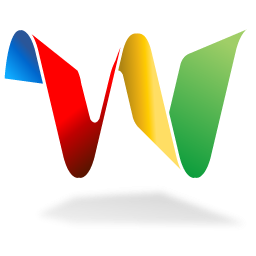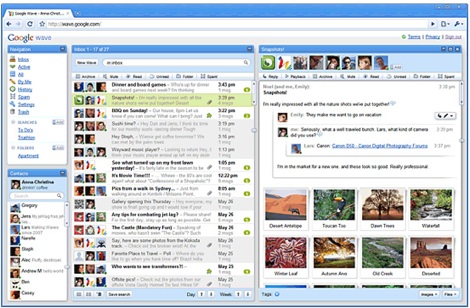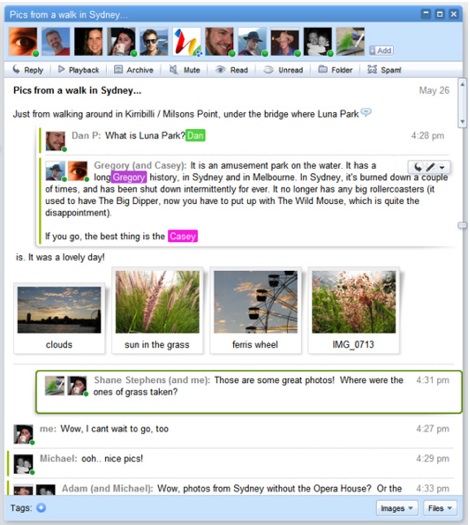Gizmodo Australia: idea is to drag email and IM into real-time-so it’s free-wheeling mesh of Twitter, IM, Friendfeed really, any other kind of service presenting semi-real-time stuff in a stream. But in Google Wave, you can share and collaborate on projects, and all of this is mashed together at once, so it might be the ultimate service for people with ADD, or enterprise looking to simulate the feeling of 10 people standing around a desk scattered with a bunch of projects, but you’re all able to work on any of them simultaneously while you’re also whispering to the cute girl across the table about the new sushi place around the corner. You start a wave with any message or photo or whatever, and you bring people into the discussion, and then they can bring other people in as well (unless you block it or start kicking people out) so it’s as public or private as you want it to be. More screenshots and video after the break.. We can wait for the first chatbots demonstrated on this platform! Wave is a new communication platform by Google. It’s a Frothy Collaborative Mix of Chat, Instant Messaging, Twitter and Google Docs in Real-Time:. A “wave” is equal parts conversation and document, where people can communicate and work together with richly formatted text, photos, videos, maps, and more..
Wave is a new communication platform by Google. It’s a Frothy Collaborative Mix of Chat, Instant Messaging, Twitter and Google Docs in Real-Time:. A “wave” is equal parts conversation and document, where people can communicate and work together with richly formatted text, photos, videos, maps, and more..
How it works
 Here’s how it works: In Google Wave you create a wave and add people to it. Everyone on your wave can use richly formatted text, photos, gadgets, and even feeds from other sources on the web. They can insert a reply or edit the wave directly. It’s concurrent rich-text editing, where you see on your screen nearly instantly what your fellow collaborators are typing in your wave. That means Google Wave is just as well suited for quick messages as for persistent content - it allows for both collaboration and communication. You can also use “playback” to rewind the wave and see how it evolved.
Here’s how it works: In Google Wave you create a wave and add people to it. Everyone on your wave can use richly formatted text, photos, gadgets, and even feeds from other sources on the web. They can insert a reply or edit the wave directly. It’s concurrent rich-text editing, where you see on your screen nearly instantly what your fellow collaborators are typing in your wave. That means Google Wave is just as well suited for quick messages as for persistent content - it allows for both collaboration and communication. You can also use “playback” to rewind the wave and see how it evolved.
Google will make the code open source as a way to encourage the developer community to get involved and all kinds of cool stuff before our public launch.
Google Wave has three layers: the product, the platform, and the protocol:
- The Google Wave product (available as a developer preview) is the web application people will use to access and edit waves. It’s an HTML 5 app, built on Google Web Toolkit. It includes a rich text editor and other functions like desktop drag-and-drop (which, for example, lets you drag a set of photos right into a wave).
- Google Wave can also be considered a platform with a rich set of open APIs that allow developers to embed waves in other web services, and to build new extensions that work inside waves.
- The Google Wave protocol is the underlying format for storing and the means of sharing waves, and includes the “live” concurrency control, which allows edits to be reflected instantly across users and services. The protocol is designed for open federation, such that anyone’s Wave services can interoperate with each other and with the Google Wave service. To encourage adoption of the protocol, we intend to open source the code behind Google Wave.

history
Back in early 2004, Google took an interest in a tiny mapping startup called Where 2 Tech, founded by brothers Jens and Lars Rasmussen. They helped create what would become Google Maps. But they also started thinking about what might come next after maps. Brother Jens came up with the answer: communication. He pointed out that two of the most spectacular successes in digital communication, email and instant messaging, were originally designed in the ‘60s to imitate analog formats - email mimicked snail mail, and IM mimicked phone calls. Since then, so many different forms of communication had been invented - blogs, wikis, collaborative documents, etc. - and computers and networks had dramatically improved. So Jens proposed a new communications model that presumed all these advances as a starting point, and Lars was immediately sold.
They left the Maps team and turned Jens’ new idea into a project, which they codenamed “Walkabout.” They started with a set of tough questions:
- Why do we have to live with divides between different types of communication - email versus chat, or conversations versus documents?
- Could a single communications model span all or most of the systems in use on the web today, in one smooth continuum? How simple could we make it?
- What if we tried designing a communications system that took advantage of computers’ current abilities, rather than imitating non-electronic forms?
After months holed up in a conference room in the Sydney office, the five-person “startup” team emerged with a prototype open to share with the community.
open source: you’re invited!
If you’re a developer and you’d like to roll up your sleeves and start working on Google Wave with us, you can read more on the Google Wave Developer blog about the Google Wave APIs, and check out the Google Code blog to learn more about the Google Wave Federation Protocol.
stay up to date
If you’d like to be notified when we launch Google Wave as a public product, you can sign up at http://wave.google.com/. Google doesn’t have a specific timeframe for public release, but they are planning to continue working on Google Wave for a number of months more as a developer preview.
http://googleblog.blogspot.com/2009/05/went-walkabout-brought-back-google-wave.html and http://www.gizmodo.com.au/2009/05/google_wave_is_a_frothy_collaborative_mix_of_chat_im_twitter_and_google_docs_in_realtime-2.html


